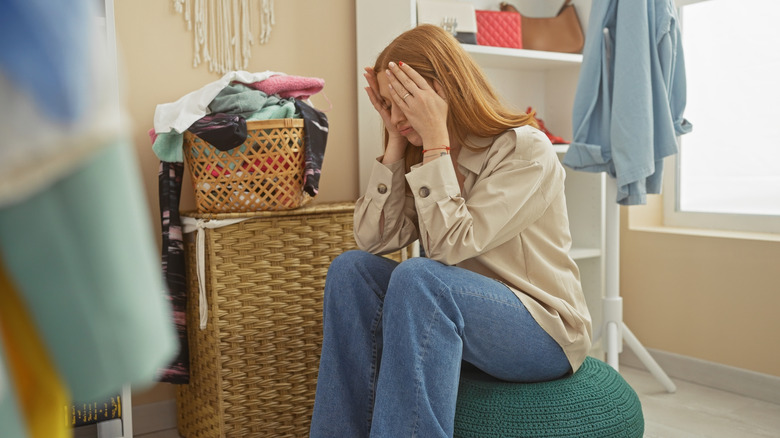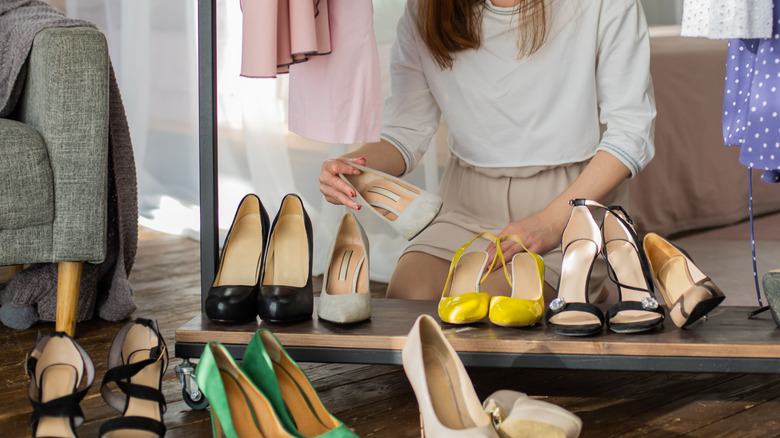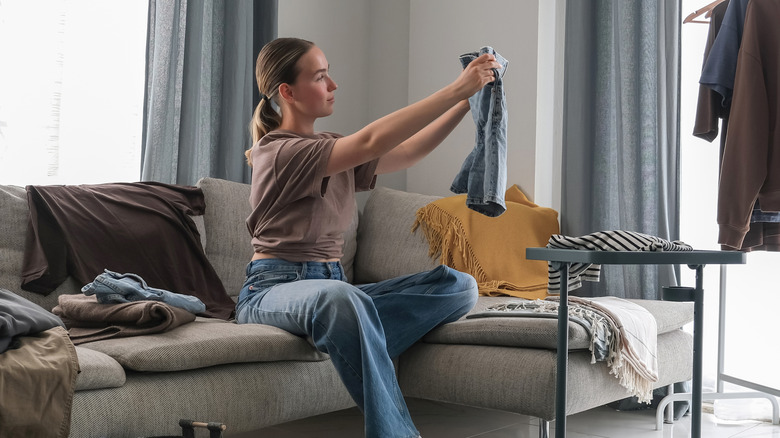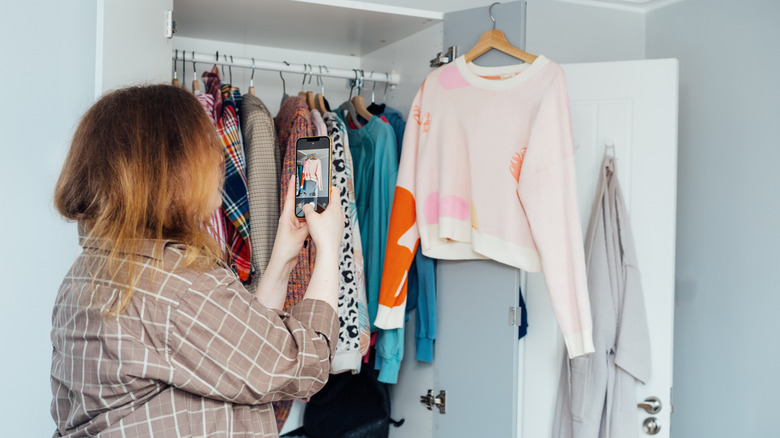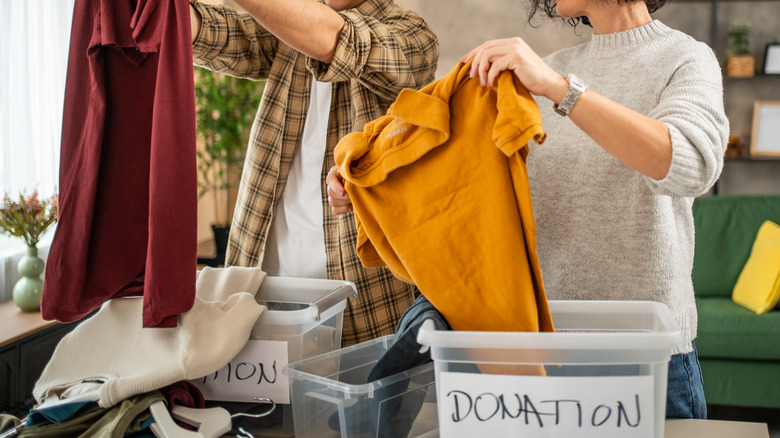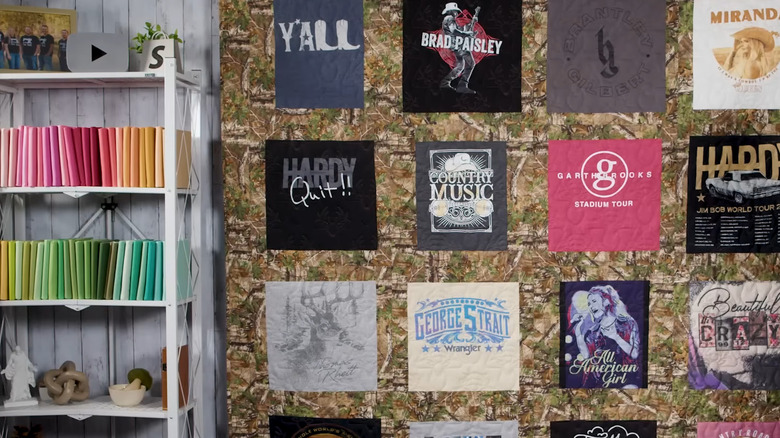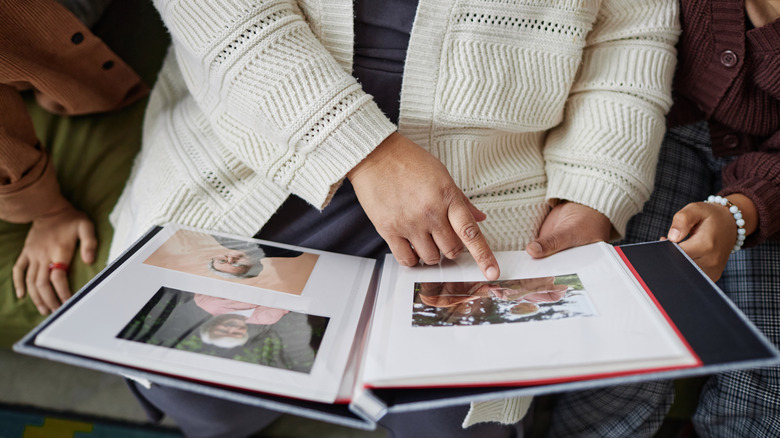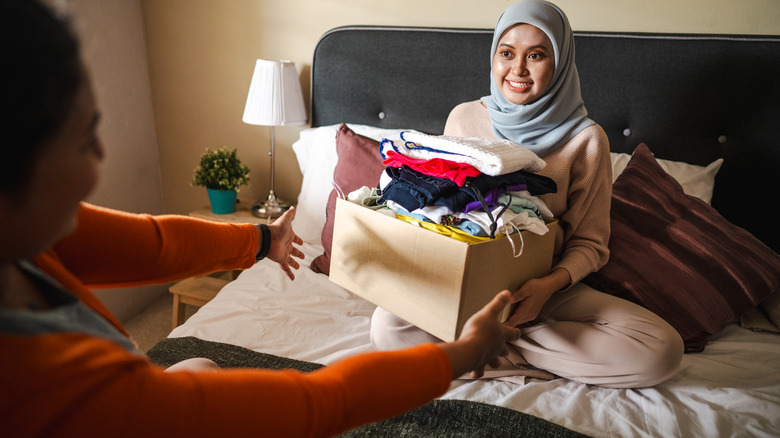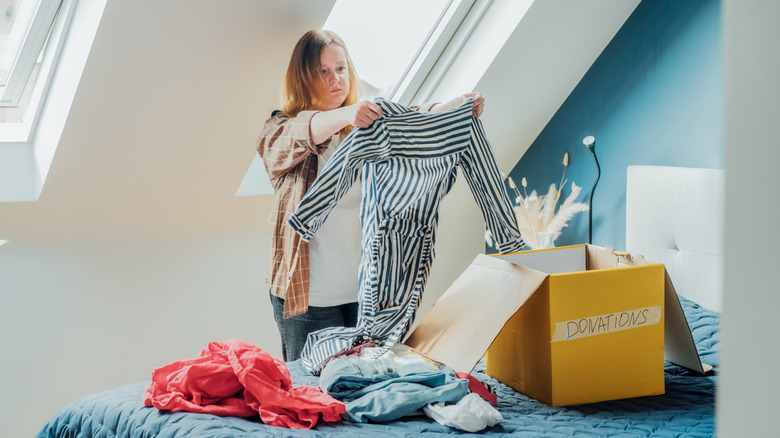Tips For Approaching Decluttering Gracefully After A Loved One Passes Away
We may receive a commission on purchases made from links.
After you lose a loved one, the last thing you want to do is declutter their possessions. Unfortunately, you may not have the luxury of time if the landlord sets a deadline, there's a foreclosure looming ahead, you're moving abroad, or simply don't have the space to house everything. And even if you aren't racing against a ticking clock, you still want to make decisions with intentional and careful consideration. Hoarding your beloved's personal effects or, alternatively, donating them all, in attempts to avoid painful emotions could lead to regrets later on.
To help you tackle this emotional task with grace (towards yourself and the memory of the one who has passed), House Digest reached out to four organizational and grief professionals for exclusive interviews. Our experts recommend taking baby steps, digitizing physical objects, seeking assistance, repurposing memorable items, and trying the Pile Plan to gracefully declutter your loved ones' assets after they pass away. Here's their complete take, along with ways you can apply each tip in real time.
Start small with just a few items of low emotional significance
While you may want to get the emotionally-heavy items out of the way first, this can make the already challenging job more difficult. So, to keep yourself from drowning in another wave of grief and abandoning the task altogether, start small. Mindy Godding, former president at the National Association of Productivity and Organizing Professionals and founder of Abundance Organizing, agrees. During an exclusive interview with House Digest, Godding shares that the best way is to "build your decluttering muscle slowly. Ease into the process by starting with a small, contained space that houses items of low emotional significance — think medicine cabinet, bedside table, or desk drawer." So, instead of starting with your loved ones' clothes or favorite accessories, begin with stuff like deciding the fate of their toiletries, going through their cleaning supplies, or emptying the compartments in their car.
Godding explains that "these types of utilitarian spaces are less likely to trigger an emotional response." And once you have a little faith in yourself, move the goal post a little further. According to Godding, these smaller wins allow you to both gain some momentum on the painful task at hand, build confidence, and allow you to weigh up how much you can handle. "Once you've tackled them, you are ready to move to more charged categories like clothes or spaces with broader scope, like a kitchen or workshop," plus you'll be better able to gauge how much your heart can handle in a day.
Don't rush the process
Another thing you want to stop when decluttering a loved one's possessions is rushing through the process. Otherwise, you can burn out (emotionally) midway through or regret your rapid-fire decisions later on. The best course of action is to let yourself grieve and take your time during these sessions. Godding advises, "Move slowly. A grieving brain is an overwhelmed brain. When your brain is overwhelmed, your 'thinking' brain goes offline and you are in a state of threat-response, which means your capacity for decision-making is at an all-time low. Be gentle with yourself, [and] give yourself a long runway."
Think of the hare and the tortoise story and channel the "slow and steady wins the race" energy. That being said, you don't want to declutter the same bedside table or medicine cabinet for a week. To ensure that doesn't happen, break each space into specific categories and set a goal for yourself. For instance, if the first item on your list is your loved ones' library, zone it off into various parts and decide which section you'll deal with when — a little grace period won't hurt, but don't procrastinate. Keep the goal clear to avoid confusion later. You can even set time limits on your phone (whatever you're comfortable with) to ensure you don't get lost in the memories and go off course.
Consider taking photos of items you don't want to physically store, but which hold a memory
Probably the hardest part of decluttering after a loved one passes away is donating or re-gifting their belongings. Sometimes, you may even have to trash a few things, particularly if they had a habit of saving scraps, things to fix (but which aren't worth the expense), etc. For the things that have true significance, but which are impractical to keep — how do you part with them without triggering strong sensations of loss? Under such circumstances, one option is to give the physical objects a digital form. Christian Bumpous, licensed professional counselor and founder of Therapie, shares how you can go about this. "Instead of keeping items, another option is to take photos of deeply meaningful objects before donating or gifting them. A single picture can be a powerful vessel for our memories while also allowing us to free up our physical space."
However, don't just rely on your device's memory. You don't want to lose the images if something goes wrong with your smart device. Always upload the pictures to the cloud or a digital folder you share with your friends and family. This way, even if you accidentally delete an image or face issues with your phone, PC, or tablet, it'll stay safe. You can even dedicate a flash drive(s) to safeguard the digital memories. Feeling guilty letting go of the physical objects? Bumpous has some solid advice. "Remind yourself that releasing belongings is not the same as releasing the connection you've held with your loved one. Even if objects change hands, your memories and love remain intact."
Work alongside a trusted partner
Even if you resolve to stay the course and try your best to declutter your loved ones' belongings per the set timeline, you may find it difficult to handle everything on your own. To ensure grief doesn't pull you under and halt your progress, reach out to your friends and family for support. You can either lean on them emotionally or ask them to lend you a hand while organizing. It can be a blend of both, too. Whichever approach works for you, don't be afraid to ask for help. Godding advises enlisting a trusted individual who won't slow you down. "If you are struggling to make progress on your own, bring in someone who will ask thoughtful questions, keep you focused, and gently move you forward."
However, if your entire family is grief-stricken or isn't present in a physical form, don't be afraid to consult a professional. When hiring a professional organizer, Godding advises reaching out to someone who specializes in working with bereaved families. They'll offer a safe space for you to share anecdotes or recall stories of days gone by while bringing order to the mess at hand.
Rehome items in ways that honor their memory
Although it may seem difficult to sort through your loved ones' belongings and set aside the items you're ready to part with, that's the easy part. In reality, the task of rehoming them is often harder. It's because you wouldn't want to simply throw away the objects or give them to someone who wouldn't appreciate them. To make the process less heart-wrenching, Godding advises honoring a loved one's memory by rehoming their personal effects in a thoughtful manner. "Think about the values of the person whom you are grieving. What were their interests, passions, and causes that they supported? It can feel rewarding to gift their possessions in a way that continues their legacy and supports people or organizations that were important to them during their lives."
For instance, if they loved helping out in the community, you can donate their clothes and furniture to charities they were passionate about or homeless shelters. For things like hobby or recreation supplies, try to locate crafters, fishing clubs, sewing groups, etc., where the items might be highly appreciated. For family heirlooms, see if your immediate or extended family might want them. If they don't, consider putting your family heirlooms on display or finding a collector who will truly value the items. You can even check with your local libraries or museums; they may happily house original artworks or rare books. This way, you can still look at them whenever you feel like without keeping everything in your home.
Give cherished items a new life through repurposing
You may be reluctant to part with your mother's favorite dresses, father's hats, or spouse's gardening tools — basically, things that remind you so much of them. But the dresses might not fit, the hats may be too weird for your tastes, and you might not possess a green thumb. For such items, Godding proposes you upcycle them to give them a new lease on life. "If an item that belonged to your loved one can no longer be used for its intended purpose, find a way to creatively repurpose it into something that will serve."
If you have a sewing machine, cut up the old dresses, shirts, and sweaters into square pieces, and turn them into a quilt or pillowcase, you name it. If you aren't comfortable repurposing the fabrics, Godding has a workaround. "Nowadays, with the rise of maker platforms like Etsy, you can easily find artisans who will craft something new out of almost anything. Dad's army dress blues can become a handbag, or Grandma's mink stole can become a teddy bear." Similarly, you can transform old gardening tools into rustic wind chimes or unique artwork. If you're a pro DIYer and have the tools to start woodworking at home, repurpose old bookcases into snazzy wine racks, or simply refinish them to suit your interior style. For things you don't want to repurpose: Place things like pins, brooches, and handwritten notes and letters into a shadow box, like Califortree's Frame Shadow Box. And for jewellery that's not quite your style or rings that don't fit, consider having the stones reset.
Remember that auctions and estate sales are an option, even for less valuable items
Even after you rehome your loved ones' possessions and repurpose a few, there's a good chance you'll still be left with a significant amount of things, many of which you may be able to sell. Diane Greenhalgh, professional home organizer (certified in residential organizing, household management, and life transitions) and owner of Tiny to the Max, explains the possibility of auctions, even if you don't have anything with a high monetary value. "Don't think that because you don't have anything of huge financial value like expensive art and fancy cars that you can't use an auction." Greenhalgh explains that nowadays there are some auction-type services which allow you to sell less high-end categories of home items, including things like cleaning supplies. Besides efficiently moving lower value items, you might even stumble upon old household items that are more valuable than you think. "There are also companies that specialize in estate clear-outs that can help you sell what can be sold and remove everything else," says Greenhalgh. This way, you won't have to deal with anything you've already decided to part with.
Decide whether you'd like to handle the auction or estate sale yourself or trust a professional team. In case you don't have the emotional or physical bandwidth to host these events, speak with two or three organizers, check their online reviews, and insurance details (must cover liability). They should also be bonded, or you might face issues receiving the sale proceeds on time.
Figure out which items really are a part of family history
If you find your "keep" pile getting too high when going through your loved ones' belongings, review the memorabilia once again. This will help you determine whether they're truly worth a spot in your home or family. Greenhalgh suggests tying each object to a memory to make informed decisions. She explains, "For keepsakes, is it a memory that you share? If you are worried about getting rid of something that may hold some family history, ask yourself if you know what it is and why it's important."
For example, "If it's a photo, do you know the people in the photo and what's going on? If not, and you can't find anyone who does, let it go. It's not family history if no one knows what it is." Another instance can be you debating the fate of a dinnerware set. Did your mother inherit it from her mother? Or, maybe your father scrimped and saved for a long while to buy the expensive set for your mom? If so, you might want to keep and cherish it even if the set isn't complete. However, if you aren't aware of its sentimental value and it doesn't evoke pleasant memories, let it go.
Know that the person who passed doesn't want to trap you with unwanted possessions
Although it'll be hard to let go of your loved ones' possessions, especially items they cherished while alive, don't feel obligated to keep them if they don't serve a purpose. Greenhalgh puts this nugget in a nutshell, saying, "Keeping something that you don't want is not honoring your loved one. Even if your loved one left something to you specifically. Putting it in a closet to gather dust is not honoring that item or the memory. Better to find someone who will love it and use it in the way it deserves." You can have your extended family and their friends look through the pieces you don't have room for and take anything they like. This will minimize your guilt and ensure the objects find a new loving owner.
However, sometimes, you might still be left with a lot of personal effects with no takers. But rather than renting a storage unit to house them or trying to cram them in your home, give yourself permission to rehome them. Even if you can't find the perfect person to pass the item onto, this doesn't mean you shouldn't part with it. Greenhalgh reminds us that, "if in the end you can't find a good home, your loved one wouldn't want you to be strapped with something you don't want. So let it go knowing you did all you could to find a good home."
Make fair rules for items that other family members feel should be kept
When decluttering your loved ones' personal effects after their passing, it's, of course, a good idea to check in with any siblings and close family members. This way, they can choose the items they'd like to keep and the ones they're fine with donating or putting up for sale at an auction. But don't take on the responsibility for the ugly green sofa your brother insisted on keeping. Greenhalgh explains, "If someone in the family is insisting that something should be kept even if no one wants it, make a rule that whoever is insisting it be kept is responsible for transporting and keeping it."
Be clear from the beginning and ensure they understand that they'd have to transport and house the objects. If the family member is a digital nomad lock down all details regarding the object while you can still reach them. If possible, set a time frame and ask them to get back to you with all the necessary information by the end of the period. So long as you have set out clear directives and the person is aware that you can't store the item for them, feel free to include the items in the estate sale or donate them if no arrangements have been made. And if it's something that will change hands after a certain period, jot down those details, too. You don't want to leave room for future arguments.
Try the Pile Plan for clothing and personal items
Sorting through and categorizing your beloved's clothing and personal items will ease the decluttering process. But the five pile rule you may follow for organizing your personal belongings won't offer satisfactory results in this scenario. Kimberly Blair, founder and lead practitioner at The Guides Holistic Therapies, is a huge fan of the Pile Plan. Discussing the concept, she explains, "The Pile Plan, gives grievers an approach on how to navigate one of the most painful tasks after a loved one passes away; what to do with clothes and personal items ensuring that there isn't any regrets."
The first step is to "take all the items and physically put them all out and go through everything one at a time." Then, divide them into three piles to categorize them and deal with them accordingly. Blair suggests saving pile A for all the items you're sure about bringing home with you, and relegating the next pile (B) to objects you're 100% positive you won't be keeping. This is anything you'd like to donate, sell, or give your other family members goes here. Pile C is for the in-between items. Basically, it'll house all the pieces you aren't sure about keeping but don't feel confident parting with, either.
Once you have everything sorted into three neat piles, Blair outlines, "Put pile A either back in the closet or bring home with you. Give pile B to individuals, groups, etc. Load up pile C into bags and boxes and take them to the garage, storage unit, or attic." She advises that you give yourself a month and then bring out everything you put in the last pile and sort them again. "This approach accomplishes the goal of keeping what you want and not holding on to things you don't need. If you find that another pile C is there after going through the process, wait three months, and move through it once more until eventually, you'll be done."
